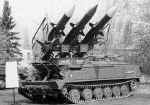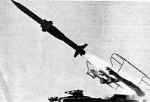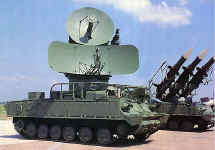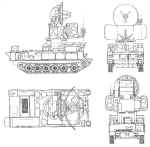Weapons
ZRK SD Kvadrat
- Details
- Created: 12 October 2006
- Written by Anti Aircraft - (Self Propelled - Tracked)
- Hits: 13633
It is estimated that the SA-6a missile has a length of 5.7 metres, body diameter of 0.335 metres, a wing span of 1.245 metres, a tail span of 1.524 metres and has a launch weight of 599kg with a 56kg HE-fragmentation warhead. Proximity and contact fuses are armed after some 50 metres of flight. The basic SA-6a has a maximum effective range of 24,000 metres and has a minimum effective range of 3,000 metres, the minimum engagement height is 100 metres when using the fire control radar and 80 metres when in the optical tracking mode, the maximum effective altitude is about 11,000 metres. Reload missiles are carried on modified 6x6 trucks and are loaded manually onto the launcher by a crane carried on the rear of the loader vehicle. Reloading an TEL takes approximately 10 minutes.
- The ZRK-SD Kvadrat SAM mounted on the TELAR vehicle.
The ZRK-SD Kvadrat SAM during a test launch.
The fire control radar has a maximum range of 55 - 75km and a 10,000 metres altitude capability depending upon the conditions & target size and performs limited search, low altitude detection and/or acquisition, pulse Doppler IFF interrogation, target tracking & illumination, missile radar command guidance and secondary radar missile tracking functions. It also carries the fire control computers for the SA-6 missile battery. Some modified fire control radar have been observed with a TV camera with a 30km range to enable the battery to remain in action even if the vehicle's radar is jammed or forced to shut down due to threats from anti-radiation missiles. This radar can also be linked to the launch vehicles by either a radio data link or a 10 metres long cable for direct data input to the launcher's systems. The data link antenna is carried on the right forward hull corner of the TEL.
The STRAIGHT FLUSH radar which provides guidance for the ZRK-SD Kvadrat SAM.
The foldable 28km range dish antenna is of the conical scanning type and is used for low altitude H-band sector search scans, target tracking and target illumination. The lower parabolic antenna is the G-band medium altitude target acquisition and early warning radar with a 55-75km range, with the lower feed for medium to high altitude coverage and the upper feed for low altitude coverage. The fire control radar can begin target acquisition at its maximum range of 75km, and begin tracking and illumination at 28km. The radar can only illuminate a single target and control three missiles at any one time so normal practice when a target track has been initiated is to normally order the launch of two and sometimes three weapons from one or more TELs.
An all-view line drawing of the STRAIGHT FLUSH radar.
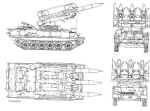
An all-view line drawing of the ZRK-SD Kvadrat SAM.
With radar up, reaction time from a dormant condition through the target acquisition, IFF interrogation and lock-on phases to missile launch is about three minutes. If the radar vehicle is already active then the time taken for the sequence is reduced to between 15 to 30 seconds. A battery is able to become mobile and relocate to an alternate firing position in 15 minutes from systems being shutdown. A battery is able to become mobile and relocate to an alternate firing position in approximately 15 minutes from systems being shutdown. In 1977, a new version - the SA-6b, was mounted on an SPU medium tracked transporter. The SPU carried three SA-6b missiles and also an associated Fire Dome H/I-band missile guidance illuminator radar is fitted on the front end of the launcher assembly.
Note: The Indian Army has decided to upgrade it's Kvadrat air defence systems, due to inordinate delays in the Akash missile program which was supposed to replace the Kvadrat system. The $200 million upgrade program for 100 Kvadrat (and 50 OSA-AKM) systems is being done by Warsaw-based Centrex Trading Limited, Poland's state-owned agency for defence exports, and was expected to be completed by 2002-end. It is not sure whether this has been accomplished. The upgrade package includes replacement of both air defence systems' radars, signaling equipment and radio receivers. The package also includes new digital fire-control and power-pack systems.
